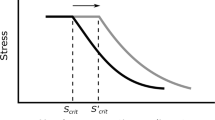Summary
Measurements of oxygen consumption and lactate production were used to estimate the ATP production in porcine carotid arteries. Changes in the total energy metabolism were correlated with changes in force which was altered by changing the muscle length under maximum stimulation. This tension-dependent metabolism could be used to distinguish between cross bridge and other ATP utilization. The tension-dependent metabolism was equal under K+-depolarization or histamine stimulation. Tension cost was 300x smaller than skeletal muscle while the cross bridge cycle duration 30x longer.
Similar content being viewed by others
References
Baguet, F. and Gillis, J.M.: Energy cost of tonic contraction in a lamellibranch catch muscle. J. Physiol. London198, 127–143 (1968).
Beviz, A., Lundholm, L., Mohme-Lundholm, E., and Vamos, N.: Hydrolysis of adenosinetriphosphate and creatinephosphate on isometric contraction of vascular smooth muscle. Acta Physiol. Scand.65, 268–272 (1965).
Bülbring, E. and Needham, D.M. (eds.): A discussion on recent developments in vertebrate smooth muscle physiology. Phil. Trans. Roy. Soc. London B.265, 1–231 (1973).
Curtin, N.A., Gilbert, C., Kretzschmar, K.M. and Wilkie, D.R.: The effect of the performance of work on the total energy output and metabolism during muscular contraction. J. Physiol. London238, 455–472 (1974).
Daemers-Lambert, C.: Dissociation par le fluorodinitrobenzene des effects ATP-asiques, metabolique et contractile, lies a l'augmentation de la concentration en potassium extracellulaire, dans le muscle lisse arterial (carotide de bovide). Angiologica5, 293–309 (1968).
Herlihy, J.T. and Murphy, R.A.: Length-tension relationship of smooth muscle of the hog carotid artery. Circ. Res.33, 275–283 (1973).
Mohme-Lundholm, E., and Vamos, N.: Influence of Ca++ deficiency and pronethalol on metabolic and contractile effects of catecholamines and K-ions in vascular muscle. Acta Pharmacol. et Toxicol.25, 87–96 (1967).
Mrwa, U., Achtig, I. and Rüegg, J.C.: Influences of calcium concentration and pH on the tension development and ATPase activity of the arterial actomyosin contractile system. Blood Vessels11, 277–286 (1974).
Murphy, R.A., Herlihy, J.T. and Megerman, J.: Force-generating capacity and contractile protein content of arterial smooth muscle. J. Gen. Physiol.64, 691–705 (1974).
Needham, D.M.:Machina Carnis. The biochemistry of muscular contraction in its historical development. pp. 559–566. Cambridge, England: Cambridge University Press (1971).
Paul, R.J. and Kushmerick, M.J.: Apparent P/O ratio and chemical energy balance in frog sartorius musclein vivo. Biochim. Biophys. Acta347, 483–490 (1974).
Paul, R.J. and Peterson, J.W.: Relation between length, isometric force, and O2 consumption rate in vascular smooth muscle. Am. J. Physiol.228, 915–922 (1975).
Paul, R.J. and Rüegg, J.C.: Biochemistry of vascular smooth muscle: energy metabolism and the proteins of the contractile apparatus. In: Altura, B.M. and Kaley, G. (eds.)Microcirculation. Baltimore: University Park Press 1976 (in press).
Paul, R.J., Peterson, J.W. and Caplan, S.R.: A nonequilibrium thermodynamic description of vascular smooth muscle mechanochemistry. I. The rate of oxygen consumption: a measure of the driving chemical reaction. J. Mechanochem. & Cell Mot.3, 19–32 (1974).
Peterson, J.W. and Paul, R.J.: Aerobic glycolysis in vascular smooth muscle: relation to isometric tension. Biochim. Biophys. Acta357, 167–176 (1974).
Pittman, R.N. and Duling, B.R.: Oxygen sensitivity of vascular smooth muscle I. in vitro studies. Microvascular Res.6, 202–211 (1973).
Rüegg, J.C.: Smooth Muscle Tone. Physiol. Rev.51, 201–248 (1971).
Sandberg, J.A. and Carlson, F.D.: The length dependence of phosphorylcreatine hydrolysis during an isometric tetanus. Biochem. Z.345, 212–231 (1966).
Schirmer, R.H.: Die Besonderheiten des contractilen Proteins der Arterien. Biochem. Z.343, 269–282 (1965).
Author information
Authors and Affiliations
Rights and permissions
About this article
Cite this article
Paul, R.J., Glück, E. & Rüegg, J.C. Cross bridge ATP utilization in arterial smooth muscle. Pflugers Arch. 361, 297–299 (1976). https://doi.org/10.1007/BF00587295
Received:
Issue Date:
DOI: https://doi.org/10.1007/BF00587295



